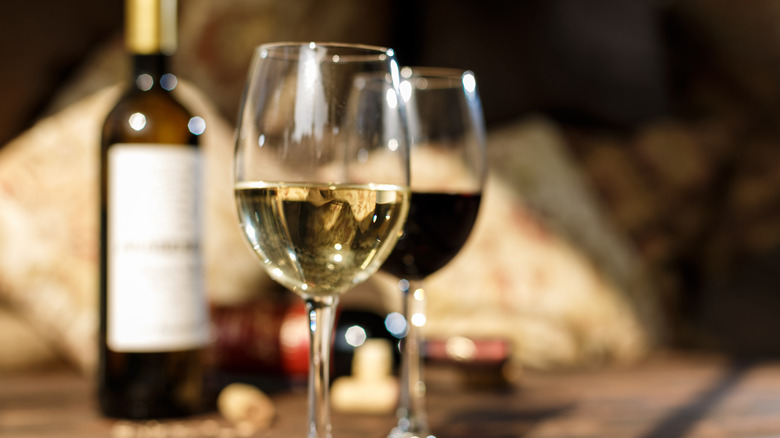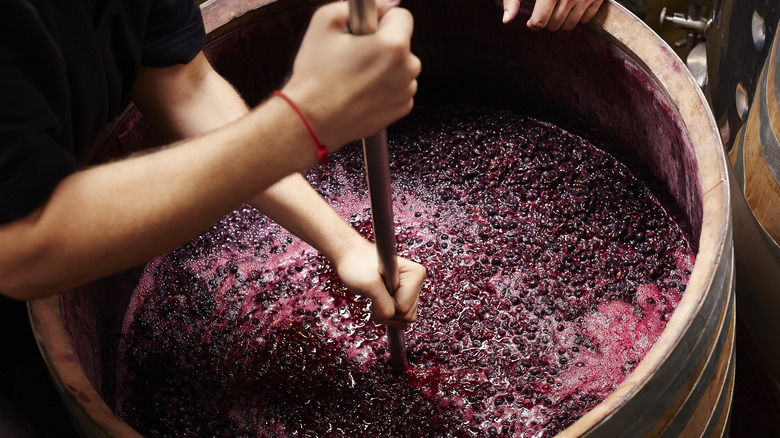Wait, Non-Alcoholic Wine Isn't Just Grape Juice?
For some, the idea of non-alcoholic wine conjures up images of overly sweet grape juice. But in reality, non-alcoholic wine is a sophisticated and complex alternative to traditional wine. While alcohol is a fundamental component of regular wine, the process of making non-alcoholic wine is almost identical — the grapes used in non-alcoholic wine must still undergo the same vinification process as their boozy counterparts. This process includes steps such as fermentation and aging in barrels, which ultimately give the wine its signature flavor and structure.
So, if a beverage doesn't undergo this process, then yes, it is simply juice, not wine. However, most high-quality non-alcoholic wines maintain all of the same flavors, structure, and complexity of alcoholic wines sans the ethanol, which is what makes regular wine alcoholic and intoxicating. With the recent rise of health-conscious consumers — fueled largely by Gen Z, according to the National Public Health Information Coalition — this alternative, alcohol-less tipple has become a popular choice for those looking to enjoy their favorite beverage without the buzz (some people are even cooking with non-alcoholic wine).
Whatever the reason for reaching for an alcohol-free bottle of vino, it's important to recognize that it's much more than just a bland substitute for traditional wine — it's a beverage that offers its own unique and pleasurable sensory experience. To truly enjoy alcohol-free wine, though, it's helpful to explore its origins, how it's made, and some of the best options on the market.
How non-alcoholic wine is made
Non-alcoholic wine may sound like a misnomer to many, but it is a burgeoning category, and the craft of creating it is anything but elementary. There are three main methods currently in use, and each involves removing the alcohol while preserving the flavor of the wine (unfortunately, most methods remove the aromas). They all also start with regular grapes, fermentation, and aging. The difference is in the vinification process.
Vacuum distillation, for example, removes alcohol and other volatile components from the wine. After distillation, the aromatics are then blended back into the wine. Some non-alcoholic winemakers, however, rely on spinning cone columns. According to Decanter, these columns use "inverted cones and centrifugal forces" to separate the constituent elements of the wine. Repeated low-temperature evaporation and condensation occur during the spinning cone column's use, and the resulting non-alcoholic wine is well-balanced and flavorful. Finally, you can make non-alcoholic wine through reverse osmosis.
Regardless of the method used, most brands add sugar back into the mix to mimic the mouthfeel of alcoholic wine and then slap a label on it depending on the resulting alcoholic content. According to the FDA, a "dealcoholized" or "alcohol-removed" label is misleading if the wine contains more than 0.5% alcohol by volume. Look for these words to ensure you're drinking non-alcoholic wine and not well-marketed grape juice.
Best ways to drink non-alcoholic wine
Non-alcoholic wine can be enjoyed just like any other wine — on its own, chilled properly to the right temperature according to its variety. Most (well-made) non-alcoholic wines offer the same flavor profiles — such as acidic, fruity, or earthy notes — without the added alcohol, and that's something to sip and savor.
When speaking in an interview with NPR, Charles Vaubin said, "In France, we always use the fact that wine is not about alcohol; it's about culture, about gastronomy. And it's interesting to have this aspect in nonalcoholic products." So, pair it like you would with gastronomic delights such as cheese, charcuterie, and grilled vegetables. For a summer gathering, try pairing non-alcoholic rosé with a fresh salad or a light pasta dish. Or, for a more luxurious experience, try pairing it with lobster or crab, and savor the exquisite taste.
You can also get creative and use non-alcoholic wine in cocktail recipes. It provides a flavorful base for cocktails without the need for excessive amounts of alcohol or, in some cases, sugar. For example, a non-alcoholic wine spritzer can be created by combining non-alcoholic white wine, sparkling water, and fresh lemon juice over ice. Or, try a non-alcoholic sangria by combining non-alcoholic red wine, sliced fruit, and a splash of citrus soda. Who knows — you might just be pleasantly surprised by its taste and versatility.


